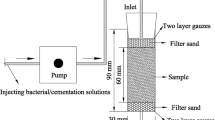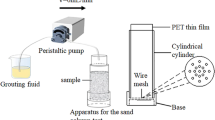Abstract
Microbe-induced calcite precipitation is a sustainable improvement technique for sandy soil, which can alter the properties of sand via microbial activity. In this study, we investigated the loose-sand-consolidation effect by controlling the injection velocity, bacterial and cementing-solution concentrations, and hold times. The results demonstrate that, as the cyclic batch increases, the utilization rate of the bacterial fluid increases and both the optical density (OD600) of the bacteria and urease activity decrease. Moreover, it was determined that a 3-h hold time for a 0.5 mol/L cementing solution with a cementing fluid velocity of 2 mL/min has the greatest bonding effect. The final strength of the loose sand with an increase in calcium carbonate content was further discussed.










Similar content being viewed by others
References
Schneider M, Romer M, Tschudin M et al (2011) Sustainable cement production—present and future. Cem Concr Res 41:642–650
Cayan DR, Bromirski PD, Hayhoe K et al (2008) Climate change projections of sea level extremes along the California coast. Clim Change 87:57–73
Karol RH, Mortensen BM, Martinez BC et al (2010) Bio-mediated soil improvement. Ecol Eng 36:197–210
Karol HR (2003) Chemical grouting and soil stabilization, Revised and Expanded, 3rd edn. Rutgers University, Marcel Dekker, Inc., New Jersey
Ramachandran SK, Ramakrishnan V, Bang SS (2001) Remediation of concrete using micro-organisms. ACI Mater J 98:3–9
De Muynck W, De Belie N, Verstraete W (2010) Microbial carbonate precipitation in construction materials: a review. Ecol Eng 36:118–136
Salifu E, MacLachlan E, Iyer KR et al (2016) Application of microbially induced calcite precipitation in erosion mitigation and stabilisation of sandy soil foreshore slopes: a preliminary investigation. Eng Geol 201:96–105
Khaliq W, Ehsan MB (2016) Crack healing in concrete using various bio influenced self-healing techniques. Constr Build Mater 102:349–357
Hammes F, Boon N, de Villiers J et al (2003) Strain-specific ureolytic microbial calcium carbonate precipitation. Appl Environ Microbiol 69:4901–4909
Whiffin VS, van Paassen LA, Harkes MP (2007) Microbial carbonate precipitation as a soil improvement technique. Geomicrobiol J 24:417–423
Ivanov V, Chu J (2008) Applications of microorganisms to geotechnical engineering for bioclogging and biocementation of soil in situ. Rev Environ Sci Bio Technol 7:139–153
Nemati M, Voordouw G (2003) Modification of porous media permeability, using calcium carbonate produced enzymatically in situ. Enzyme Microb Technol 33:635–642
Achal V, Mukherjee A (2015) A review of microbial precipitation for sustainable construction. Constr Build Mater 93:1224–1235
Okwadha GD, Li J (2010) Optimum conditions for microbial carbonate precipitation. Chemosphere 81:1143–1148
Huang Y, Luo XG, He J et al (2009) Studies on the experiment of microbiologically-induced calcite precipitation in silica. J Southwest Univ Sci Technol 24:65–69 (in Chinese)
Rong H, Qian CX, Zhang L et al (2015) Cementation process of microbe cement. J Chin Ceram Soc 43:1067–1075 (in Chinese)
Mitchell AC, Dideriksen K, Spangler LH et al (2010) Microbially enhanced carbon capture and storage by mineral-trapping and solubility-trapping. Environ Sci Technol 44:5270–5276
Knoll AH (2003) Biomineralization and evolutionary history. Rev Mineral Geochem 54(1):329–356
Rong H (2014) Preparation and binding mechanism of microbe cement. Dissertation, Southeast University, Nanjing, China (in Chinese)
Neupane D, Yasuhara H, Kinoshita N et al (2015) Distribution of mineralized carbonate and its quantification method in enzyme mediated calcite precipitation technique. Soils Found 55:447–457
Zhao Q (2014) Experimental study on soil improvement using microbial induced calcite precipitation (MICP). Dissertation, China University of Geosciences, Beijing, China (in Chinese)
Harkes MP, van Paassen LA, Booster JL et al (2010) Fixation and distribution of bacterial activity in sand to induce carbonate precipitation for ground reinforcement. Ecol Eng 36:112–117
Stocks-Fischer S, Galinat JK, Bang SS (1999) Microbiological precipitation of CaCO3. Soil Biol Biochem 31:1563–1571
Acknowledgements
This study was supported by the National Key Research & Development Program of China (no. 2016YFC0401904), the Science Fund for Creative Research Groups of the National Natural Science Foundation of China (no. 51621092), the National Natural Science Foundation of China (nos. 51309177 and 51409187), and the Program of Introducing Talents of Discipline to Universities (No. B14012).
Author information
Authors and Affiliations
Corresponding author
Rights and permissions
About this article
Cite this article
Tang, Y., Lian, J., Xu, G. et al. Effect of Cementation on Calcium Carbonate Precipitation of Loose Sand Resulting from Microbial Treatment. Trans. Tianjin Univ. 23, 547–554 (2017). https://doi.org/10.1007/s12209-017-0084-8
Received:
Revised:
Accepted:
Published:
Issue Date:
DOI: https://doi.org/10.1007/s12209-017-0084-8




